
Prof. Emeritus Steve Brenner
CV
Academic Training
B.S. Meteorology and physical oceanography; City College of New York, 1975
Ph.D. Meteorology; Massachusetts Institute of Technology, 1982
Professional Employment
1980-1985 US Air Force Geophysics Laboratory, Research scientist
1985-2003 Israel Oceanographic and Limnological Research, Senior scientist and head of Department of Physical Oceanography
1994-2000 Bar Ilan University, Department of Geography, adjunct senior lecturer
2000-2005 Bar Ilan University, Department of Geography and Environment, Associate professor
2003-2009 Bar Ilan University, Department of Geography and Environment, department chairperson
2005-2022 Bar Ilan University, Department of Geography and Environment, Full professor 2022- Bar Ilan University, Department of Geography and Environment, Professor emeritus
Specialization fields
1. Numerical modeling of oceans and atmospheres
2. Circulation in the Mediterranean Sea
3. Circulation in the Gulf of Elat
4. Operational ocean forecasting
5. Large scale air-sea interaction
6. Short and long range climate prediction
7. Circulation in the Dead Sea
Publications
Chisholm, D.A., C.H. Yang, K. Mitchell, S. Brenner, S. Yee, and I. Halberstam, 1984. Summary of a workshop on global NWP cloud modeling, 25-27 October 1983, Bedford, Massachusetts. Bull. Amer. Meteror. Soc., 65, 706-712.
Brenner, S., 1984. Comments on "computation of grid-point values of the wind components in spectral models." Mon. Wea. Rev., 112, 1283-1284.
Brenner, S., 1985. The effects of vertical resolution and layer distribution on a global forecast model. Seventh Conference on Numerical Weather Prediction, 17-20 June 1985, Montreal, Canada. American Meteorological Society, Boston, p. 303-309.
Robinson, A.R., A. Hecht, N. Pinardi, J. Bishop, W. Leslie, Z. Rosentroub, A.J. Mariano, and S. Brenner, 1987. Small synoptic/mesoscale eddies and the energetic variability of the eastern Levantine basin. Nature, 327, 131-134.
Brenner, S. 1988. A comparison of various numerical solutions of the hydrostatic equation. Eighth Conference on Numerical Weather Prediction, 22-26 February, 1988, Baltimore, MD. American Meterological Society, Boston, p. 438-441.
Brenner, S., 1989. Structure and evolution of warm core eddies in the eastern Mediterranean Levantine basin. J. Geophys. Res., 94, 12,593-12,602.
Rozentroub, Z. and S. Brenner, 1990. On the relationship between eastern Med surface fluxes and precipitation in Israel. Isr. J. Earth-Sci., 39, 119-124.
Brenner, S., 1990. The response of a large scale model to changes in eastern Mediterranean sea surface temperature. Isr. J. Earth-Sci., 39, 125-130.
Krom, M.D., S. Brenner, L. Israilov, and B. Krumgalz, 1991. Dissolved nutrients, preformed nutrients and elemental raios in the in the southeastern Mediterranean Sea. Oceanol. Acta, 14, 189-194.
Krom, M.D., N. Kress, S. Brenner, and L.I. Gordon, 1991. Phosphorous limitation of primary productivity in the eastern Mediterranean. Limnol. and Oceanogr., 36, 424-432.
Brenner, S., Z. Rozentroub, M. Krom, and Y. Bishop, 1991. The mixed layer / thermocline cycle of a persistent warm core eddy in the eastern Mediterranen. Dyn. Atmos. Oceans, 15, 457-476.
Brenner, S., 1992. Medium and extended range forecasts with a coupled ocean-atmosphere model. The Yale Mintz Memorial Symposium on Climate and Climate Change, 28-31 December 1992, Jerusalem, p. 74-76.
Ozsoy, E., U. Unluata, A. Hecht, S. Brenner, T. Oguz, Z. Rozentroub, M.A. Latif, and Y. Bishop, 1991. On the variability of the Levantine Basin circulation and hydrography: a review of the persistence and distribution of synoptic/mesoscale circulation features. Dyn. Atmos. Oceans, 15, 421-456.
Krom, M.D., S. Brenner, N. Kress, A. Neori, and L.I. Gordon, 1992. Nutrient dynamics and new production in a warm core eddy in the eastern Mediterranean Sea. Deep Sea Res., 39, 467-480.
Wolf-Vecht, C., N. Paldor, and S. Brenner, 1992. Hydrographic indications of advective/convective effects in the Gulf of Aqaba (Elat). Deep Sea Res., 39, 1393-1401.
The POEM Group, 1992. General circulation of the eastern Mediterranean. Earth-Sci Rev., 32, 285-309.
Krom, M.D., S. Brenner, N. Kress, A. Neori, and L.I. Gordon, 1993. Nutrient distributions during an annual cycle across a warm core eddy in the eastern Mediterranean Sea. Deep Sea Res., 40, 805-826.
Brenner, S., 1993. Long term evolution and dynamics of a persistent warm core eddy in the eastern Mediterranean. Deep Sea Res. II, 40, 1193-1206.
Ozsoy, E., A. Hecht, U. Unluata, S. Brenner, H. Sur, J. Bishop, T. Oguz, Z. Rozentraub, and M.A. Latif., 1993. A synthesis of the Levantine Basin circulation and hydrography, 1985-1990. Deep Sea Res. II, 40, 1075-1120.
Brenner, S., 1994. Response of the eastern Mediterranean mixed layer and heat storage to variations in surface heat fluxes. Isr. Meteorol. Res. Papers, 5, 74-78.
Berman, T., S. Brenner, and N. Paldor, 1995. Salt fingering in the Cyprus eddy. Geophysical Monographs, 94, 251-260.
Genin, A., B. Lazar, and S. Brenner, 1995. Vertical mixing and coral death in the Red Sea following the eruption of Mt. Pinatubo. Nature, 377, 507-510.
Malanotte-Rizzoli, P., A.R. Robinson, W. Roether, B. Manca, A. Bergamasco, S. Brenner, G. Civitarese, D. Georgopoulos, P.J. Haley, S. Kioroglou, H. Kontoyannis, N. Kress, M.A. Latif, W.G. Leslie, E. Ozsoy, M. Ribera d’Alcala, I. Salihoglu, E. Sansone, and A. Theocharis, 1996. Experiment in eastern Mediterranean probes origin of deep water masses. EOS Trans. Amer. Geophys. Union, 77, 305, 311.
Brenner, S., 1996. Response of a mixed layer ocean model in 30-day December forecasts with a coupled ocean-atmosphere model. J. Climate, 9, 3337-3356.
Zohary, T., S. Brenner, M.D. Krom, D. Angel, N. Kress, W.R. Li, A. Neori, and Y.Z. Yacobi, 1998. Build up of microbial biomass during deep winter mixing in an eastern Mediterranean warm core eddy. Mar. Ecolog. Progr. Ser., 167, 47-57.
Malanotte-Rizzoli, P., B. Manca, M. Ribera, A. Theocharis, S. Brenner, G. Budillon, and E. Ozsoy, 1999. The Eastern Mediterranean in the 80’s and 90’s: The big transition in the intermediate and deep circulations. Dyn. Atmos. Oceans, 29, 365-395.
Leon-Coto, S., N. Kress, C. Brenes-Rodrigues, and S. Brenner, 1999. Una contibucion a la ecologia del Golfo de Nicoya (A contribution to the ecology of the Gulf of Nicoya). Uniciencia, 15/16, 35-37. (In Spanish)
Pinardi, N. and the MFSPP Partners, 1999. The Mediterranean ocean forecasting system: The first phase of implementation. OCEANOBS-99, 6 pp.
Manca, B., A. Theocharis, S. Brenner, H. Kontoyiannis, and E. Sansone, 1999. Water masses and transports between the Aegean and Levantine Basins during LIWEX 1995. In: The Eastern Mediterranean as a Laboratory Basin for the Assessment of Contrasting Ecosystems, P. Malanotte-Rizzoli and V.N. Eremeev (Editors), Kluwer Academic Publishers, pp. 483-494.
Berman, T., N. Paldor, and S. Brenner, 2000. Simulations of wind-driven circulation in the Gulf of Elat (Aqaba). J. Mar. Systems, 26, 349-365.
Govindan, R.B., D. Vjushin, S. Brenner, A. Bunde, S. Havlin, and H.J. Schellnhuber, 2001. Long range correlations and trends in global climate models: comparison with real data. Physica A, 294, 239-248.
Kress, N., S.L. Coto, C. Brenes, S. Brenner, and C. Arroyo, 2001. Horizontal transports and seasonal distributions of nutrients, oxygen, and chlorophyll-a in the Gulf of Nicoya, Costa Rica. Continent. Shelf Res., 22, 51-66.
Roads, J. and S. Brenner, 2002. Global model seasonal forecasts for the Mediterranean region. Isr. J. Earth-Sci., 51, 1-16.
Vjushin, D., Govindan, R.B., S. Brenner, A. Bunde, S. Havlin, and H.J. Schellnhuber, 2002. Lack of scaling in global climate models. J. Phys.: Condens. Matter, 14, 2275-2282.
Govindan, R.B., D. Vjushin, S. Brenner, A. Bunde, S. Havlin, and H.J. Schellnhuber, 2002. Global climate models violate scaling of the observed atmospheric variability. Phys. Rev. Lett., 89, 028501.
Berman, T., N. Paldor, and S. Brenner, 2003. The seasonality of the tidally driven circulation in the Gulf of Elat. Isr. J. Earth Sci., 52, 11-19.
Berman, T., N. Paldor, and S. Brenner, 2003. Annual cycle of SST in the Eastern Mediterranean, Red Sea, and Gulf of Elat. Geophys. Res. Lett., 30(5), 1261, doi: 10.1029/2002GL015860
Brenner, S., 2003. Simulations with a relocatable, nested, high resolution model: the eastern Levantine experience. In: Oceanography of the Eastern Mediterranean and Black Sea, A. Yilmaz (Editor), Tubitak Publishers, Ankara, Turkey, pp. 1022-1028.
Zodiatis, G., Drakopoulos, P., S. Brenner, and S. Groom, 2003. CYCLOPS Project: the hydrodynamics of the warm core eddy south of Cyprus. In: Oceanography of the Eastern, A. Yilmaz (Editor), Tubitak Publishers, Ankara, Turkey, pp. 18-23.
Brenner, S., 2003. High-resolution nested model simulations of the climatological circulation in the southeastern corner of the Mediterranean Sea. Annal. Geophys., 21, 267-280.
Vyushin, D., I. Zhidkov, S. Havlin, A. Bunde, and S. Brenner, 2004. Volcanic forcing improves atmosphere-ocean coupled general circulation model scaling performance. Geophys. Res. Lett., 31(10), doi: 10.1029/2004GL019499
Groom, S., B. Herut, S. Brenner, G. Zodiatis S. Psarra, N. Kress, M. Krom, C. Law, and.P.Drakopoulos, 2005. Satellite derived spatial and temporal biological variability in the Cyprus eddy. Deep Sea Res. II, 52, 2990-3010.
Zodiatis, G., P. Drakopoulos, S. Brenner, and S. Groom, 2005. Variability of the Cyprus warm core eddy during the CYCLOPS Project. Deep Sea Res. II, 52, 2897-2910.
Krom, M.D., T.F. Thingstad, S. Brenner, P.Carbo, P. Drakopoulos, T.W. Fileman, G.A.F. Flaten, S. Groom, B. Herut, V. Kitidis, N. Kress, C.S. Law, M.I. Liddicoat, R.F.C. Mantoura, A. Pasternak, P. Pitta, T. Polychronaki, S. Psarra, F. Rassoulzadegan, E.F. Skjoldal, G. Spyres, T. Tanaka, A. Tselepides, P. Wassman, C. Wexels-Riser, E.M.S. Woodward, G. Zodiatis, and T. Zohary, 2005. Summary and overview of the CYCLOPS P additiona Lagrangian experiments in the Eastern Mediterranean. Deep Sea Res. II, 52, 3090-3108.
Zodiatis, G., S. Brenner, D. Hayes, I. Gertman, and. P. Drakopoulos, 2006. The Atlantic water in the eastern Mediterranean Levantine basin. Geophys. Res. Abstr., 8, 07862 (Sred-ID: 1607-7962/gra/EGU06-A-07862.
Brenner, S., I. Gertman, and A. Murashkovsky, 2007. Pre-operational ocean forecasting in the southeastern Mediterranean: Model implementation, evaluation, and the selection of atmospheric forcing. J. Mar. Systems, 65, 268-287.
Rosentraub, Z. and S. Brenner, 2007. Circulation over the southeastern continental shelf and slope of the Mediterranean Sea: Direct current measurements, winds, and numerical model simulations. J. Geophys. Res. – Oceans, 112, C11001, doi:10.1029/2006JC003775, 21 pp.
Brenner, S., A. Murashkovsky, and I. Gertman, 2008. Assessment of one year of high-resolution operational forecasts for the southeastern Mediterranean shelf region in the MFSTEP project. Ocean Sci. Discuss., 3, 2059-2085.
Ben Sasson, M. S. Brenner, and N. Paldor, 2009. Estimating air-sea heat fluxes in semi-enclosed basins: The case of the Gulf of Elat (Aqaba). J. Phys. Oceanogr., 39, 185-202, doi: 10.1175/2008JPO3858.1.
Dubinsky, Z., O. Chomsky, and S. Brenner, 2011. The 2004 Asian tsunami's havoc and death toll: Nature's wrath or human shortsightedness? In: Tsunami Threat - Research and Technology, N.-A. Morner (Ed.), Intech, 10 pp., doi: 10.5772/10503.
Brenner, S., 2012. Numerical modeling of the ocean circulation: From process studies to operational forecasting – the Mediterranean example. In: Hydrodynamics – Natural Water Bodies, H.E. Schulz (Ed.), Intech, pp. 111-128, doi: 10.5772/30077.
Brenner, S., 2012. The circulation in the Mediterranean Sea, in: Life in the Mediterranean Sea: A look at habitat changes, N. Stambler (Ed.), Nova Science Publishers, pp. 99-127.
Guez, O., A. Gozolchiani, K. Yamasaki, Y. Berezin, S. Brenner, and S. Havlin, 2012. Climate network structure evolves with North Atlantic Oscillation phases. Europhys. Lett., 38006, 4 pp., doi: 1029/0295-5075/98/38006.
Brenner, S. and S. Shalev-Yitzhaki, 2013. Can regional ocean models forced with global climate model surface fluxes reconstruct the present steady climate? The Mediterranean Sea example. In: The Meditgerranean Sea: Temporal Variability and Spatial Patterns, AGU Monographs. Under revision.
Nehorai, R., L. Hochman, I. Gertman, S. Brenner, A. Mushkin, and N.G. Lensky, 2013. Satellite observations of turbidity in the Dead Sea. J. Geophys. Res. – Oceans, 118, 1-15, doi: 10.1002/jgrc.20204.
Nehorai, R., N.G. Lensky, S. Brenner, and I.M. Lensky, 2013. The dynamics of the skin temperature of the Dead Sea. Advan. Meteorol., 2013, 296714, 9 pp, doi: 10.1155/2013/296714.
Brenner, S., 2014. The circulation in the Mediterranean Sea: Past, present, and future, In: The Glory of the Sea: Stability and Change in the Aquatic Systems of Israel, N. Stambler, T. Lotan, B. Goodman, and I. Berman-Frank (Eds.), Israel Association for Aquatic Sciences, pp. 47-58 (in Hebrew).
Malanotte-Rizzoli and the Pan-Med Group, 2014. Physical forcing and physical/biochemical variability of the Mediterranean Sea: a review of unresolved issues and directions for future research. Ocean Sci., 10, 267-279, doi:10.5194/os-10-281-2014.
Suari, Y. and S. Brenner, 2014. RGB plots as a tool for the simultaneous visualization of mutiple data layers in a two dimensional space. PLoS ONE., 9(7), e102903, doi:10.1371/journal.pone.0102903.
Suari, Y. and S. Brenner, 2015. Decadal biogeochemical history of the southeast Levantine basin: Simulations of the river Nile regimes. J. Mar. Sys., 148, 112-121, doi:10.1016/j.marsys.2014.02.004.
Brenner, S., 2015. Oil spill modeling in the southeastern Mediterranean Sea in support of accelerated offshore oil and gas exploration. Ocean Dyn., 65, 1685-1697, doi:10.1007/s10236-015-0902-2.
Brenner, S. 2018. Long term dispersion of the discharge brine from multiple desalination facilities. The Israel Society of Ecology and Environmental Science Annual Conference for Science and the Environment, 20-21 June 2018, Rehovot, Israel (Poster). doi:10.13140/RG.2.2.24786.45767
Michael, Y., I.M. Lensky, S. Brenner, A. Tchetchik, N. Tessler, and D. Helman, 2018. Using high-hesolution Planet satellites constellation images to assess economic damage of a wildland–urban interface fire. Remote Sensing, 10(9),1497, 23 pp. doi:10.3390/rs10091479
Reiche, S., C. Hubscher, S. Brenner, C. Betzler, and J.K. Hal, 2018. The role of internal waves in the late Quaternary evolution of the Israeli continental slope. Marine Geology, 406 (1 December 2018), 177-192. doi:https://doi.org/10.1016/j.margeo.2018.09.013.
Brenner, S. 2019. High resolution ocean model simulations of the dispersion of desalination discharge brine from multiple, large-scale, coastal facilities located in relatively close proximity. American Meteorological Society 99th Annual Meeting, 17th Symposium on the Coastal Environment, 6-10 January 2019, Phoenix, AZ, USA
Arnon, A., S. Brenner, J.S. Selker, I. Gertman, and N.G. Lensky, 2019. Seasonal seiche dynamics governed by stratification stability and wind: Analysis of High resolution observations from the Dead Sea. Limnol. and Oceanogr., 64, 1864-1882. https://doi.org/10.1002/lno.11156.
Brenner, S., 2019. The risk of potential cross border transport of oil spills in the semi-enclosed Eastern Mediterranean Sea. In: Oil and Gas Wells, S-A. Ouadfeul and L. Aliouane (eds), IntechOpen. https://doi.org/10.5772/intechopen.86205
Michael, Y., D. Helman, O. Glickman, D. Gabay, S. Brenner, and I. Lensky, 2020. Forecasting fire risk with machine learning and dynamic information derived from satellite vegetation index time-series. Science of the Total Environment, 2020, 142844, https://doi.org/10.1016/j.scitotenv.2020.142844.
Hagay, O. and S. Brenner, 2021. Sensitivity of simulations of extreme Mediterranean storms to the specification of sea surface temperature: comparison of cases of tropical-like cyclones and explosive cyclogenesis. Atmosphere, 2021, 12, 921. https://doi.org/10.3390/atmos12070921.
Michael, Y., G. Kozokaro, S. Brenner, and I. Lensky, 2022. Improving wildfire simulation accuracy using SAR and time series of satellite-based vegetation indices. Remote Sensing, 2022, 14, 2941. https://doi.org/10.3390/rs14122941.
Zodiatis, G., S. Brenner, I. Gertman, T. Ozer, S. Simoncelli, M. Ioannou, and S. Savva, 2023. Twenty years of in-situ monitoring in the southeastern Mediterranean Levantine basin: basic elements of the thermohaline structure and of the mesoscale circulation during 1995-2015. Frontiers in Marine Science, 9:1074504. https://doi.org/10.3389/fmars.2022.1074504.
Brenner, S., I. Gertman, T. Ozer, S. Simoncelli, and G. Zodiatis, 2023. Dominant features and variability of the mesoscale circulation and thermohaline structure of the eastern Levantine during the post POEM period 1995-2015. EGU General Assembly 2023, Vienna, Austria, 24–28 Apr 2023, EGU23-14768, https://doi.org/10.5194/egusphere-egu23-14768, 2023.
Brenner,S., I.Avishay, N. Tachnai, and I. Lensky, 2023. Shelf-open sea exchange processes across the narrow shelf of the southeastern Mediterranean Sea. COSS-TT International Coordination Meeting 2-4 May 2023, Montreal Canada. Abstract (pp. 37-38), Presentation.
Research
Recent projects
Red Sea - Dead Sea Water Conveyance Project (RDC)
This project was conducted as part of the overall feasibility study to assess the viabaility and potential environmental consequences of pumping large amounts of water from the northern Gulf of Eilat (Aqaba), part of which would be desalinated to provide fresh water mainly to the Kingdom of Jordan, while the remaining salty brine would be poured into the Dead Sea. Funding was provided by the World Bank. I served as the Deputy Team Leader and Scientific Coordinator of the Red Sea component of the RDC study, which was conducted under the auspices of Thetis, an Italian engineering and environmental services company. The other partners in this project included scientists from the Interuniversity Institute for Marine Research in Eilat, the Hebrew University, Israel Oceanographic and Limnological Research, the Marine Sciences Station in Aqaba, and Stanford University.
In addition to the administrative tasks, I was responsible for the development and application of the simulation models used to assess the potential environmental impacts of withdrawing water from the northern Gulf of Eilat.
In the Dead Sea component of the study, I adapted a three dimensional ocean circulation model to study the dispersion of the salty desalination brine discharge in the unique conditions of the Dead Sea. This component was conducted under the auspices of TAHAL and the Geological Survey of Israel (GSI), a government institute operating under the Earth Science Research Administration within the Ministry of National Infrastructures.
Current projects
Circulation in the Dead Sea
The Dead Sea is a hypersaline, terminal lake located at the lowest point on the land surface of the Earth. Its current level is more than 429 m below MSL, and due to a negative water balance (mainly anthropogenic), the lake level has been dropping at an average rate of more than 1 m/yr for more than 30 years. The mean salinity has also been steadily increasing and today is close to 280 psu. The region of the Dead Sea is a unique landscape that has important historical, cultural, and economic value and therefore such an extreme change of the lake has significant environmental and economic consequences. In recent years there has been a notable increase in observing and monitoring of the lake through continuous measurements from several fixed buoys as well as during quasi-regular cruises. In order to complement the measurements and improve our understanding of the dynamics of this unique lake a three dimensional circulation model based on the Princeton Ocean Model is being developed. Previous modeling efforts were limited mainly to a one dimensional column model which was coupled to a comprehensive physio-chemical model and used for long term multi-decadal simulations. In this study the focus is on understanding the dynamical processes that control the lake-wide circulation on time scales ranging from days to seasons. The first step was to replace the equation of state with an equation appropriate for the hypersaline conditions, in addition to some minor tuning of the turbulence closure scheme. Preliminary simulations focused the role of wind forcing in various seasons. Next, a case study of a recent unusual winter flooding event, during which the lake level rose by more than 20 cm over a two month period, was considered. The model successfully simulated the observed transition from holomictic (complete vertical mixing) to meromictic (patial vertical mixing) conditions and epilimnion dilution during this event, as well as the restoration of holomictic conditions when the level started to drop again.
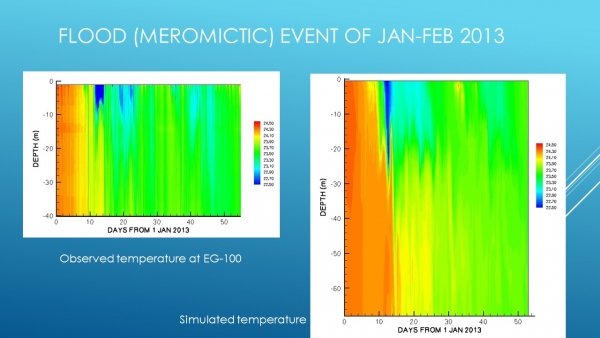
More recently the model has been used to study seiches and internal waves in the Dead Sea. Seiches and internal waves in stratified lakes, which are generated on the thermocline, are affected by the seasonally varying stratification and by wind forcing. Seasonally, the amplitude of the thermocline fluctuations are anti-correlated with the density difference between the water layers, with the largest fluctuations when stratification is weak in spring/fall and moderate to weak fluctuations in mid-summer when stratification is fully developed. Power spectra of the observed wind as well as the measured and simulated lake level and thermocline depth show a pronounced diurnal period during summer, suggesting forcing by the diurnally varying wind. During spring and fall, when the water column stability is weaker, longer wind periods appear in addition to the diurnal mode. Accordingly, the lake level and thermocline depth fluctuations respond at lower frequencies. The longer wind periods are closer to the lake’s first vertical normal mode, suggesting that resonant amplification of the internal waves may explain the observed lower frequency response of the level and thermocline oscillations. Systematic decrease of the stratification stability originating from anthropogenic intervention over the past four decades (due to the dropping lake level and increasing salinity), has led to an increase in the amplitudes and periods of the internal waves.
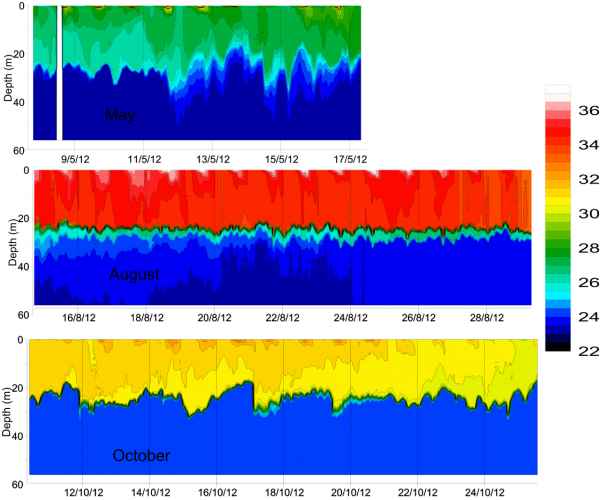
Time series of observed thermocline depth fluctuations in May, August, and October
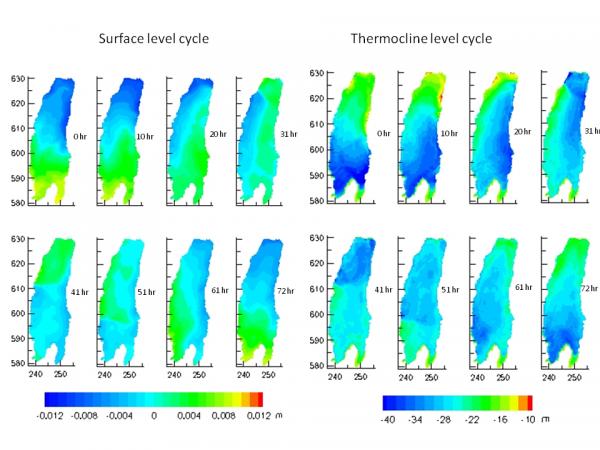
Progression of the sieche in of the seiche in the surface height (left) and in the depth of the thermocline (right), for the three-day model period 16 Oct 2012, 00:00 to 19 Oct 2012, 00:00. The time in hours since the 16Oct 00:00 is noted on each panel.
Oil spill modeling in the eastern Mediterranean
Since the discovery of major reserves in the eastern Levantine basin over the past six to seven years, exploration and drilling for natural gas and oil has proceeded at an accelerated pace. Israel and Cyprus are at advanced stages of exploration and preliminary production. A major gas reserve has just been discovered off the coast of Egypt and Lebanon has mapped blocks for licensing. As drilling and production proceed in this confined region the risk of a potential oil spill increase significantly. The highly variable ocean currents and winds will transport and spread any slick and spills, often in unanticipated directions. Deep water wells are especially prone to cross border transport. This risk has been assessed through a series of hindcast simulations with the MEDSLIK oil spill model forced with currents produced with a high resolution ocean model dynamical downscaling of the MOON/MyOcean Mediterranean Sea reanalysis and winds from the ECMWF atmospheric reanalysis. The scenarios considered are defined as worst case, uncontrolled well blowouts, located in the drilling zones of each of the countries mentioned above, that continue to discharge oil for several weeks.
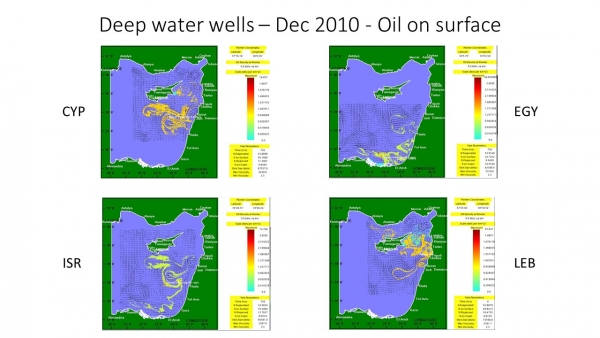
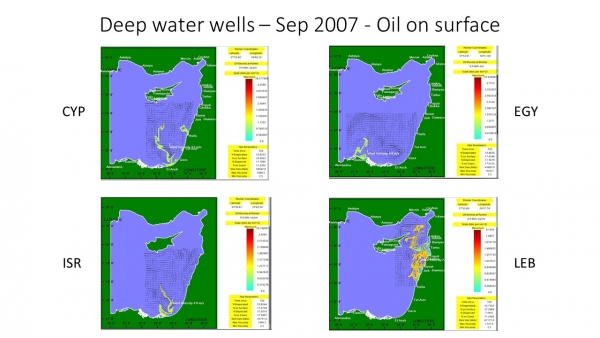
Long term dispersion of the discharge brine from multiple desalination facilities
In recent years Israel has become a world leader in the technology and use of desalination to supplement the meager and dwindling natural fresh water supplies which are further stressed due to increasing population. Today nearly 50% of the water consumed in Israel is supplied from desalination. Five desalination facilities located along the coast produce nearly 90% of this amount through desalination of seawater (~600 MCM/yr). A roughly equivalent amount of reject brine with salinity nearly twice that of the intake seawater is discharged back into the sea. In order to assess the long term dispersion and potential effects of the discharge brine, a series of high spatial resolution (~440 m grid) simulations were conducted with the three dimensional Princeton ocean model run for a period of five years. The "discharge" simulation included the five discharge outlets, two located near the surface at the coast (Ashkelon and Hadera), and three submerged outfalls (Ashdod, Soreq, and Palmahim) located in water depth of ~20 m. The following figures show the near bottom salinity in the fifth year of the desalination simulation. After the initial nearfield dilution, the diluted brine plume will be dispersed by the far field currents. For the three subsurface discharges, after the initial dilution and plume rise, the brine will still be denser than the ambient seawater and therefore sinks and spreads near the sea floor. The two surface discharges (Ashkelon and Hadera) are mixed with cooling water from the power plants (7-10°C above ambient temperature) in ratios of 4.7:1 and 8.3:1, respectively. This offsets the density increase due to the higher salinity of the brine and therefore the plume is dispersed more effectively throughout the water column.

Near bottom maps of salinity in winter of the final year

Near bottom maps of salinity in summer of the final year
In summer the brine is mainly transported to the north while in winter and in the transition seasons the brine is more likely to be transported across the shelf and downslope. The discharges diluted with cooling water from power plants appear to mix and disperse more effectively than the subsurface brine discharges
Sensitivity of high impact weather events to changes in the Mediterranean sea surface temperature
Local air-sea interaction over the Mediterranean may amplify the effects of climate change. This study investigates the sensitivity of simulations of two different high impact weather events to changes in the specification of sea surface temperature (SST) using a regional atmospheric model. First we assess the impact of specifying SST from two reanalysis data sets with differing spatial resolution. The simulated tropical like cyclone is slightly stronger in the case of the lower resolution SST which is warmer over the formation region, most notably in the maximum rainfall which is ~7% higher. The differences in the two explosive cyclone simulations are negligible, most likely due to intensification occurring mainly over land. We then test the sensitivity of the storms to a range of SST anomalies. The TLC showed a clear trend of increasing storm intensity as SST rises. These results suggest that SST plays a direct role in determining the intensity of the storm. For the explosive cyclone there is no clear trend in dynamical intensity except for the highest warming anomalies. However the rainfall increases with the magnitude of the SST anomaly. Our results suggest that extreme weather events over the Mediterranean will become more extreme if SST increases as the climate warms, assuming that upper air conditions do not change.
Observed (left panel) and simulated (right panel) mean sea level pressure for the tropical like cyclone (medicane) of Dec 2005.
Minimum mean sea level pressure at the peak of the medicane for SST anomalies ranging from -5 to +5 º C
Media
Environmental Studies at Bar Ilan University
Erosion of the coastal cliffs in Israel
http://forward.com/news/108003/is-seaside-construction-causing-israel-s-cliffs/
Oil spills in the Eastern Mediterranean
http://zavit.org.il/לנפט-אין-דרכון/
http://finance.walla.co.il/item/2971652
Hurricane Irma - Sep 2017
http://www.nrg.co.il/online/1/ART2/894/268.html
Climate change in the Indian subcontinent - Haaretz 17 Jul 2018
A tribute to Walter Munk on his passing at the age of 101 - Zavit and Ynet (in Hebrew) 14 Mar 2019
Extreme flooding in Venice, November 2019 - Walla
Rising level of Lake Kinneret, February 2020 - Times of Israel
Level of Lake Kinneret, March 2021 - Jerusalem Post
COVID-19 and Climate Change - Jerusalem Post 29 Jul 2021
Severe flooding and sinkhole formation - Newsweek 13 Jan 2023
Last Updated Date : 04/07/2023



